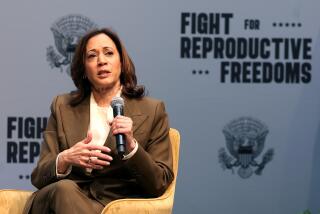Pro-Choice Camp Still in Shock, but Ready to Act : Reaction: Many in the abortion-rights movement are calling the killing of Dr. David Gunn a catalyst that will lead to a broader agenda and increased involvement.
- Share via
The slaying of Dr. David Gunn has left abortion-rights supporters angry, sad and fearful--and more determined than ever to pursue a greatly expanded range of reproductive health options.
“On the one hand, we’re still in shock,” said Brenda Joyner, who runs the Feminist Women’s Health Center of Tallahassee, Fla. “On the other hand, people are ready to act, that’s for sure.”
Many in the abortion-rights movement termed Gunn’s killing on March 10 a “catalyst” that will generate increased involvement, particularly at the grass-roots level. Advocates of abortion rights are aiming at community-based change including improved prenatal care, psychological and economic assistance for those who do undergo abortions, and greater access to contraceptives.
“This is a turning point for us,” said Ann Thompson Cook, executive director of the Religious Coalition for Abortion Rights in Washington, D.C. “We are declaring a broader agenda that is not just about abortion rights, but about reproductive rights.”
Cook called Gunn’s death a tragic reminder that “if we thought our problems were over when we elected a pro-choice President, we were wrong.”
After 12 years of opposition from the Reagan and Bush administrations, many abortion-rights defenders cheered when Bill Clinton and a new Congress took office in Washington.
“People said, ‘It’s over, we’ve won,’ ” said Joyce Schorr, who directs the National Council of Jewish Women’s Campaign for Choice in Los Angeles.
But Schorr said the jubilation quickly gave way to somnolence, and a false sense of security among some abortion-rights supporters.
“There was that big yawn,” she said, noting that attendance at Campaign for Choice meetings began dropping after the November election. “People were going back to sleep.”
Joyce Cunha, acting director of Mass Choice in Boston, said that the indifference was chillingly reminiscent of the reaction that followed the Supreme Court landmark Roe v. Wade decision legalizing abortion in 1973. “After Roe, we lost our momentum.”
And, now, said Sara Pines, communications director for NARAL, the National Abortion Rights Action League, “The absolute worst thing we could do would be to fall back on complacency, the way we did in ’73 after Roe.”
Even the election of a more sympathetic Congress and President, “only provides opportunities, not guarantees,” said Patricia Ireland, president of the National Organization for Women.
Ireland urged “a guarded kind of optimism--a caveat that says, ‘Be on your toes.’ ”
To some abortions-rights leaders, the new environment signals an even more difficult task than in the past.
Frances Kissling, president of Catholics for a Free Choice in Washington, said the consistently defensive strategies of oppositional politics over the last 12 years “were very easy.”
But now, Kissling said, “the question is, can the pro-choice movement turn itself into policy wonks?
“Can we pass pro-choice legislation, as opposed to preventing anti-choice legislation?”
Three major abortion-rights bills are pending in Congress: FOCA, or the Freedom of Choice Act; the Freedom of Access to Clinic Entrances Act; and legislation to repeal the Hyde Amendment, which prohibits federal funding for abortions in almost all instances.
Kissling contended that “the high visibility of the death of Dr. Gunn probably makes the passage of some of this legislation more likely.” But others in the abortion-rights movement are turning their sights from the nation’s capital to their local clinics.
In many parts of the country in recent years, women seeking abortions have had to wade through human blockades, often organized by groups such as Operation Rescue. Frequently, volunteer escorts help guide women through the rings of abortion opponents that surround many clinics.
But “physicians, nurses and clinic personnel” have also been “targeted by anti-choice terrorist groups for a campaign of harassment and hate,” according to the Religious Coalition for Abortion Rights of Southern California.
In response, the Southern California RCAR launched a “No Need to Hide” campaign on March 2--a week before Gunn’s death. The program seeks to bring attention to attempts by abortion-rights opponents to curtail the work of doctors and clinic personnel.
Southern California RCAR’s Bunnie Riedel said the “No Need to Hide” campaign would be extended nationally. In addition, with “close to 500 clergy for choice in Southern California alone,” Riedel said her group was also focusing on local endeavors such as “getting people to go to city council meetings to make sure funny things don’t happen in terms of zoning laws.”
Riedel said Gunn’s violent death galvanized many members of the religious community.
“My phone’s been ringing off the hook,” she said. “People are up in arms.”
Joyce Schorr shared Riedel’s hope that “the sleeping majority of Republicans and Democrats alike in this country who support the right to abortion” would be roused.
“With the murder of Dr. Gunn, it has become apparent that the abortion-rights movement is no longer just marches and rallies. It’s a war zone,” she said.
Planned Parenthood Federation of America president Pamela Maraldo said hostilities have reached a point where “women feel they have to do hand-to-hand combat just to take care of their own bodies.”
To assist such women, Schorr’s group last year created the Women’s Reproductive Rights Assistance Project (WRAPP), which provides funding for women who must travel to obtain abortions.
Abortion-rights strategists also are focusing on what Joyce Cunha called a “redefined agenda” that will “not just keep abortion safe and legal, but make it less and less necessary.”
That position mirrored the views of Brenda Joyner, who has worked in the abortion-rights movement for 20 years.
“What we want to do, of course, is to limit the need for abortion,” said Joyner. “That is where the movement is going today.”
More to Read
Sign up for Essential California
The most important California stories and recommendations in your inbox every morning.
You may occasionally receive promotional content from the Los Angeles Times.










